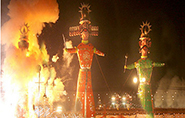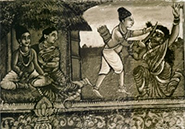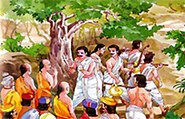Paid Services
Dussehra 2017: Celebration Of Mankind Over Evil
Dussehra is celebrated to memorialize the victory of good over evil. According to our Scriptures, on the 10th day of Shukla Paksha in the month of Ashwin, Lord Rama killed Ravana, the demon king of Lanka. In 2017, it will be observed on 30th September. It is also known as Vijayadashami. In some parts of Southern India, it is also known as Durga Puja or Dasara. To know more, read on..
What Is Dussehra?
 Dussehra is a fascinating Hindu festival that symbolizes the establishment of good on earth. It is celebrated on the tenth day of lunar month Ashvin, following the nine pious days of Navratri.
Dussehra is a fascinating Hindu festival that symbolizes the establishment of good on earth. It is celebrated on the tenth day of lunar month Ashvin, following the nine pious days of Navratri.
It is also known as Vijayadashami. Vijaya means victory and Dashami means the tenth day.
After devoting severe austerity for nine days, Lord Rama destroyed the ten headed Ravana and established good over evil on the tenth day. Dussehra is the amalgamation of the words Dasa and Hara. The words together form its literal meaning - removing ten heads.
The name ‘Dussehra’ owes itself to the beheading of the ten headed Ravana by Lord Rama. Dussehra is also known as Dasara.
Like any other Hindu festival, Dasara claims more than one mythological evidences linked with it. Let’s take a look at them.
Legends of Dussehra
Let’s take a look at the mythological legends that are associated with the festival of Dussehra:
Dussehra And Ramayana
 According to Ramayana, the story behind Dasara celebration owes to the contribution by Lord Rama. It is believed that Lord Rama symbolizes his victory over King of Lanka, Ravana as the triumph of good over evil on the day of Dussehra.
According to Ramayana, the story behind Dasara celebration owes to the contribution by Lord Rama. It is believed that Lord Rama symbolizes his victory over King of Lanka, Ravana as the triumph of good over evil on the day of Dussehra.
During the 14 years of exile, Lord Rama was living in the jungles of Dandaka with his wife Sita, and brother Laxman. As depicted in the sacred Ramayana, Ravana had a sister Surpanakha who fell in love with Lord Rama and was desperate to marry him. Surpanakha started to initiate tricks and disguised herself as a beautiful lady before Lord Rama.
Lord Rama was faithful to his wife, Sita and spurned Surpanakha's advances.
In response to a dejection, Surpanakha proposed his brother, Laxman. Unlike Lord Rama, he was not polite to react and bluntly discarded her for being incompatible. Surpanakha concluded that the brothers were making fun of her and attacked Sita. Enraged by this behavior, Laxman cut off Surpanakha’s nose and the insult sent her running away.
Ramayana states that Surpanakha's insult became the reason for abduction of Sita that concluded with Ravana’s death in Lord Rama’s hands.
This made Surpanakha to ask for revenge from his brother, Ravana. She convinced Ravana about Sita’s beauty and how she could be a perfect wife to Ravana. This made Ravana to abduct Sita, by transforming himself into a disguised form.
In order to rescue his wife, Lord Rama (also known as Prabhu Ramachandra) performed ‘Chandi Home’ to receive the blessings of Goddess Durga. The worshiping period is also known as Akalbodhan in Bengal. Akalbodhan literally means the awakening of Goddess Durga in an unconventional period; it took place in the autumnal phase of the year, whereas springtime is regarded to be the actual season to worship Goddess Durga.
The rescue operation took place in the form of a fierce battle between Lord Rama (seventh incarnation of Lord Vishnu) and Ravana, the King of Lanka. Lord Rama was accompanied by Laxman, Hanuman and the vanar sena to Lanka. The battle lasted for 10 days with the ultimate triumph of Lord Rama over Ravana. He beheaded the ten headed Ravana that corresponds to the term Dasara. This became the prime reason for the observance of Dussehra or Dasara.
The ten heads possessed by Ravana symbolizes ten vices of a human being. As Dussehra or Dasara means removing ten heads, it also represents the giving away of ten evil belongings.
The belongings are compared to Ravana’s ten heads and they are:
- Kama Vasana (Lust)
- Lobha (Greed)
- Moh (Attachment)
- Mada (Pride)
- Krodh (Anger)
- Swartha (Selfishness)
- Matsara (Jealousy)
- Anyaya (Injustice)
- Ahankara (Ego)
- Amanavta (Cruelty)
Dussehra & Goddess Durga
 The origin of Dasara also claims its roots in the legend of Goddess Durga. According to legends, Mahishasura, a worshipper of Lord Shiva, had grown into an spiteful demon and started taking away lives of innocent people.
The origin of Dasara also claims its roots in the legend of Goddess Durga. According to legends, Mahishasura, a worshipper of Lord Shiva, had grown into an spiteful demon and started taking away lives of innocent people.
To stop his malevolent activities to take over the three Lokas, Brahma, Vishnu and Mahesh of Hindu Trinity united their powers to form the supreme Goddess Durga.
She entered into a war with Mahishasura that lasted for the period of nine days and on the tenth day, Goddess Durga ended the war by beheading the demon, Mahishasura.
These nine days to save the universe from destruction signify Dussehra.
Dussehra & Mahabharata
 The epic Mahabharata depicts another legend associated with Dussehra. After losing in a gambling trial with Kauravas, the Pandavas had to serve the penalty of banishment and exile themselves for 13 years. During the initial 12 years, they were punished to live in forest and the last one year, they had to conceal their true status in front of others.
The epic Mahabharata depicts another legend associated with Dussehra. After losing in a gambling trial with Kauravas, the Pandavas had to serve the penalty of banishment and exile themselves for 13 years. During the initial 12 years, they were punished to live in forest and the last one year, they had to conceal their true status in front of others.
To fulfil the second condition of concealment, they hid their weapons under a Shami tree which otherwise would leak their disguised status. As soon as the period of 13 years was over, they went to the Shami tree and retrieved their weapons after worshiping the Shami tree. It is believed that this happened on the day of Dussehra. In a way, the Pandavas proved to be triumphant by accepting the punishment and fulfilling it.
After turning over the golden pages of mythology, now it’s turn to get back to festivity.
The victory of good over evil needs to be acknowledged. But how is it done? How should we celebrate Dussehra as a symbol of goodness? Does our celebration really represent the triumph of the heroes? Let’s take a look.
How Is Dussehra Celebrated?
In North India, theatre groups take the responsibility for performing on Dussehra. They perform on the legendary tale of Rama for 10 days. The performance is called ‘Ram Leela’.. On the tenth day of Vijayadashami, effigies of Ravana are burnt in large processions. This symbolizes the burning away of the ten evil belongings.
In South India, families decorate their houses with stacks of flowers, decorating lamps and dolls. Women exchange gifts among themselves. In Mysore, Dussehra is celebrated in a royal manner and is known as Dasara. Processions of elephants are taken out to roads and traditional fairs are also arranged. The elephants carry Goddess Chamundeshwari throughout the city. It is a mirror to the early Vijayanagara empire celebrations.
Goddess Durga is worshiped for five days in East India. The devotees celebrate Durga Puja with great zeal. It is regarded as the most awaited festival in the eastern part of the country. On the tenth day of Vijayadashami, Durga idols are immersed in the rivers. This carries an emotional belonging to the people of Bengal.
Dussehra symbolizes the end to social evils, which also comprises corruption.
Let Dussehra bring an unending halt to the evil on earth.
AstroCAMP wishes all of you Happy Dussehra..!
 Best quality gemstones with assurance of AstroCAMP.com More
Best quality gemstones with assurance of AstroCAMP.com More
 Take advantage of Yantra with assurance of AstroCAMP.com More
Take advantage of Yantra with assurance of AstroCAMP.com More
 Yantra to pacify planets and have a happy life .. get from AstroCAMP.com More
Yantra to pacify planets and have a happy life .. get from AstroCAMP.com More
 Best quality Rudraksh with assurance of AstroCAMP.com More
Best quality Rudraksh with assurance of AstroCAMP.com More
Get your personalised horoscope based on your sign.



















